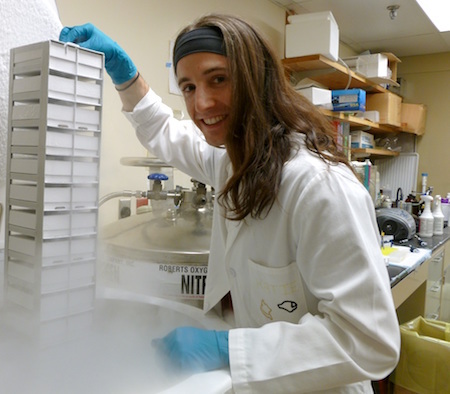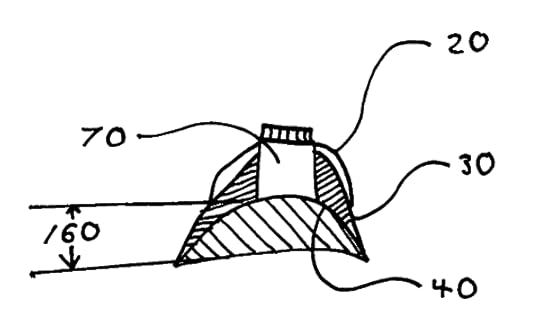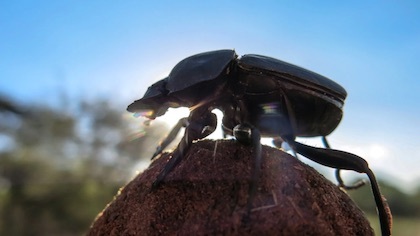Marc Abrahams's Blog, page 269
May 20, 2016
An illuminated removable nipple cover (new patent)
“There exists a need for an illuminated device that is removably attached to a body.
There also exists the need to for a body attachment with a light for users to wear over nipples.
There also exists a need for an illuminated removable nipple cover to have a batter [sic] powered LED light that is attached in the center.
There also exists a need for a removable illuminated nipple cover having a dome shape design allows room for the light and provides a better fit over the breasts.”
All these needs are met, according to a new US patent (May 17th 2016) describing an invention by Kelly Taylor of Key West, Florida. See: Illuminated Nipple Cover. US 9,339,063 B2
The patent document doesn’t provide drawings or photos of how a wearer might look with the new invention, but the inventor’s website does (batteries are included).
Note: Pasties (pron. “paste – eez”) should not be confused with Pasties (pron. “past – eez”)

May 19, 2016
Music about trout(s)
Professor Gary Grossman of the Warnell School of Forestry and Natural Resources, Athens, GA, US, not only writes about trout, see: ‘Not all drift feeders are trout: a short review of fitness-based habitat selection models for fishes’ in: Environmental Biology of Fishes, 05 / 2013; 97(5), he also sings about them, self-accompanied on a ukulele [click to hear .mp3 sampler].
“
Speckled trout, speckled trout
Shadow still then darting out
Hidden emerald dark and green
Ghost of Appalachian streams
In southern mountains ridged with age
Streams run fast o’er steepened grades
Pools and riffles stair-step down
Neath oak and hemlock’s shady boughs
Prey are sparse in Southern hills
Sedges, mayflies, stoneflies fill
But mostly tiny midges drift
Growth is slow, full stomachs missed [cont.]”
The professor has been kind enough to provide some extra detail for Improbable :
“The European residents of the Southern Appalachians called the native brook trout ‘Speckled Trout’ because of their light markings on a dark background. Genetically, these trout (charr actually) deserve subspecific status at least and they are in bad shape due to hybridization with stocked northern brook trout, potential competition with invasive rainbow trout, and habitat degradation. The song, besides describing their biology in a pleasing format, is a paean to their continued existence.”
The professor’s new CD ‘Natural Voices’, which also features songs about foraging theory, taxonomy, short-tailed shrews and red foxes, is available here. And it can also be purchased for direct download here.
Notes:
[1] Some models of Samsung washing machines play Franz Schubert’s ‘Die Forelle’ – German for ‘The Trout’ (out of copyright) to signify that the cycle has finished.
[2] The plural of ‘Trout’ is ‘Trout’ or less commonly, optionally, ‘Trouts’

May 18, 2016
Happy words from painful insect stings [podcast 64]
Justin Schmidt, an emotional fellow, took notes when he was notably stung by a different species of ant, bee, or wasp. Schmidt then turned those notes and emotions into little almost-poems, each just 15 or 20 words long. Those sting-pain notes and emotions, read aloud by QI elves, overflow this week’s Improbable Research podcast.
SUBSCRIBE on Play.it, iTunes, or Spotify to get a new episode every week, free.
This week, Marc Abrahams — with dramatic readings by James Harkin, Dan Schreiber, Anne Miller, Steve Colgan, and Alex Bell (elves from QI, the Museum of Curiosity, No Such Thing As a Fish, and No Such Thing As the News) — tells about:
Justin Schmidt‘s book, which includes the Schmidt Sting Pain Index with the poetical descriptions — The Sting of the Wild , by Justin O. Schmidt, Johns Hopkins Press, 2016. ISBN: 9781421419282.

A short video, by his university, about Justin Schmidt:
A fan video, by the San Diego Natural History Museum, about Justin Schmidt and the Schmidt Sting Pain Index:
The mysterious John Schedler or the shadowy Bruce Petschek perhaps did the sound engineering this week.
The Improbable Research podcast is all about research that makes people LAUGH, then THINK — real research, about anything and everything, from everywhere —research that may be good or bad, important or trivial, valuable or worthless. CBS distributes it, on the CBS Play.it web site, and on iTunes and Spotify).

May 17, 2016
Much to chew on about many meats
Mark A Jobling [pictured here] of the University of Leicester writes about the genetic underpinnings of exotic meats. His essay, called “Flogging a dead horse“, appears in the journal Investigative Genetics [2013, 4:5]:
People eat mules, as well as donkeys and horses, and in meat contamination testing, mule meat would appear to be horsemeat, because of the maternal inheritance of mtDNA.
Horses have 64 chromosomes, and donkeys 62, so mules and hinnies carry the intermediate odd number 63, which leads to infertility in the hybrids because oocytes fail during meiosis. As Thomas Bewick writes in his A General History of Quadrupeds, ‘Nature has providently stopped the further propagation of these heterogeneous productions, to preserve, uncontaminated, the form of each animal; without which, …every creature, losing its original perfection, would rapidly degenerate’. Occasionally, though, a female mule produces a foal after mating with a male donkey; so rare is this event that the Romans used the phrase Cum mula peperit (when a mule gives birth), equivalent to the English ‘once in a blue moon’. One such product, a healthy female in China who could plough a field by herself at 4 years of age, had 62 chromosomes, a mix of horse and donkey with a bias towards the latter [8].
In the global market-place of the internet, obtaining novel and exotic animal food products is becoming ever easier, and if you have a strong stomach and wonder how broad the scope is, just visit http://www.exoticmeatmarkets.com, where you’ll find pretty much everything (except horse…). But are these things really what they say? Contributors to Meat Science, take note – there is work for you to do!
BONUS: Joe Staton’s “Tastes Like Chicken”

May 16, 2016
“Overtaken by curiosity” Users Really Do Plug in USB Drives (which) They Find
“We investigate the anecdotal belief that end users will pick up and plug in USB flash drives they find by completing a controlled experiment in which we drop 297 flash drives on a large university campus. We find that the attack is effective with an estimated success rate of 45–98% and expeditious with the first drive connected in less than six minutes.”
The experiment, which was carried out at the University of Illinois Urbana-Champaign, also investigated the possible motives for such behaviour in memory-stick finders:
“
Users pick up the drives with altruistic intentions based on the types of the drives that were connected, the files that were opened, and the number of unconnected drives that were returned to us. However, we simultaneously note that nearly half of users are overtaken by curiosity, first opening vacation photos instead of the prominently placed résumé (which would have reasonably included contact information).”
see: ‘Users Really Do Plug in USB Drives They Find’ by Matthew Tischer (University of Illinois, Urbana-Champaign), Zakir Durumeric (University of Michigan), Sam Foster, Sunny Duan, and Alec Mori (University of Illinois, Urbana-Champaign), Elie Bursztein (Google), and Michael Bailey (University of Illinois, Urbana-Champaign). The paper will be presented next week at the 37th IEEE Symposium on Security and Privacy, Session #4: Call me on usable security, May 23rd 2016, San Jose, California.
Note: The paper focuses on the likelihood that curious finders’ machines could become infected with viruses – but Improbable also has a question about other possibilities:
Question [optional] “Given the high percentage of people who opened the files, would ‘losing’ a bunch of USB drives be a ‘good’ way for a whistleblower to anonymously* divulge data?”
*somewhat

May 15, 2016
Jake Eccles joins Luxuriant Flowing Hair Club for Scientists (LFHCfS)
Jake Eccles has joined the Luxuriant Facial Hair Club for Scientists (LFHCfS). He says:
I hope that all scientists are driven not only to better understand our world, but also by a desire to improve the lives of its occupants. Certainly, research demonstrates incredible potential to contribute to such far-reaching goals, and yet I am struck by the degree of internal hostility to which scientific communities are prone. If we, in our profession, truly possess such noble aspirations, these ought be expressed regularly through our relationships to colleagues. Thus, my hair represents an appeal to all seekers of truth and beauty: let your good will toward fellow scientists ever be luxuriant and flowing!
Jake Eccles, LFHCfS
MD/PhD (MSTP) Candidate
Dept of Microbiology, Immunology, and Cancer Biology
University of Virginia
Charlottesville, Virginia, USA


A collection of psychological research concerning beards
The British Psychological Society’s Research Digest has digested some of the psychological research concerning beards. Like beards themselves, that research comes in a both impressive and dismaying variety of quality.

May 14, 2016
Peano and the cat, and the earth
 More from the history of cats and physics, as explained in the Skull in the Stars blog:
More from the history of cats and physics, as explained in the Skull in the Stars blog:
Giuseppe Peano (1858-1932) is not well-known to the general public, but he was a formidable voice and researcher in mathematics, publishing over 200 books and papers during his lifetime….
When Peano encountered the problem of the falling cat in 1894, he immediately saw in it a kindred spirit to the nutating Earth, and began working on mathematics to explain the latter. Both problems involve an object changing its orientation in space entirely in the absence of external forces, and both problems can be qualitatively explained by internal motions of the object in question.
There is something terribly ironic about Peano’s inspiration: where physicists are normally known for oversimplifying problems — there is the famous joke about approximating a cow by a sphere — Peano went in the other direction, envisioning a sphere as a cat!
In an 1895 paper titled “Sopra lo spostamento del polo sulla terra” (“Concerning the pole shift of the Earth”), Peano presented his own mathematical theory of the phenomenon…

May 13, 2016
‘Friday the 13th: The Empirics of Bad Luck’ (study)
Bearing in mind that today is Friday the 13th, what better time to examine the question of whether the socio-economic outcomes of people born on the 13th day of the month, and of those born on Friday the 13th, differ from the outcomes of people born on more auspicious days? Investigators Dr. Jan Fidrmuc and Dr. Juan De Dios Tena Horrillo have performed one of the only large-scale studies which has attempted to find out.
“We investigate the issue at hand using the UK Labor Force Survey (LFS), a quarterly nationally-representative survey of households across the UK. Each quarter, the Office for National Statistics (ONS) interviews approximately 60 thousand households, with over 100 thousand individual respondents aged 16 and above. We use data from 1999 to 2011, which gives us around 3.9 million observations.”
The answer? Those born on the 13th, or on a Friday the 13th, “need not lose much sleep over the inauspicious circumstances of their birth” :
“We find little evidence that being born on either the 13th or on Friday the 13th is associated with dramatically worse outcomes in the labor or marriage markets. Our results indicate a small increase in the probability that men born on the 13th are employed and a small fall in the probability that they remain single (we leave it up to the reader to decide whether staying single is good or bad luck).”
The paper can be read here, in full, ‘Friday the 13th: The Empirics of Bad Luck’ (in: Kyklos, Volume 68, Issue 3, pages 317–334, August 2015)

May 12, 2016
Further adventures in dung-beetle-navigation research
Rachel Feltman chronicles, in the Washington Post, some further adventures of the Ig Nobel Prize-winning dung beetle navigation researchers:
The humble dung beetle has a fantastic way of navigating the world
If you’re a dung beetle, you spend a good portion of your life dancing around on top of a ball made of poop – a ball of poop that, with any luck, will eventually become dinner. But the researchers who’ve devoted their lives to studying these coprophagic critters say the insects have a surprising adaptation: According to a study published Thursday in Current Biology, dung beetles can take “snapshots” of their surroundings and use them to navigate.
First, a dung beetle factoid you might not know: Scientists believe that they navigate at night using the visible portion of the Milky Way – that gorgeous strip of stars and dust that appears in a sky sans light pollution. Unsurprisingly, the finding that dung beetles stare at the stars was honored with an Ig Nobel Award…

Marc Abrahams's Blog
- Marc Abrahams's profile
- 14 followers







